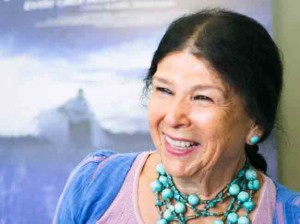Obomsawin shares Shannen’s Dream

By Barb Nahwegahbow
TORONTO – When Alanis Obomsawin’s films talk, people listen
The Abenaki filmmaker premiered her latest documentary, “Hi-Ho Mistahey!” at the 38th annual Toronto International Film Festival (TIFF) Sept. 7., when she and 30 people featured in the film walked the red carpet at the Bell Lightbox Theatre.
“Hi-Ho Mistahey!” is Obomsawin’s 42nd film in her 45-year career with the National Film Board. She’s had several premieres at TIFF and in 1993, “Kanehsatake”, her film about the Oka Crisis, won the festival prize for Best Canadian Feature Film.
Her life’s work has been fighting for justice and change, particularly in education. Fittingly, Hi-Ho Mistahey! is about a teenage girl’s fight to hold the federal government accountable for ensuring equitable funding for First Nations education. That girl was Shannen Koostachin of Attawapiskat First Nation. The movement she sparked across the country among schoolchildren of all colours has become known as Shannen’s Dream.
Obomsawin never had the opportunity to meet Shannen who died in a car accident at the age of 15 in 2010. “It was her idea to go to children when she was getting nowhere with Indian Affairs,” says Obomsawin. “She went to classrooms and talked to children. What a brilliant idea!” The film shows the people who are keeping Shannen’s Dream alive, her family and friends, and the children gathering on Parliament Hill on Valentine’s Day and imploring the federal government to “have a heart” and provide “safe and comfy schools for First Nations children”.
Shannen’s dad explained the film’s title.
When their son was very little, he pronounced “I love you” as “Hi-Ho”. “Mistahey” is Cree for “very much”. When Shannen was away from home, she’d end her phone calls saying “Hi-Ho Mistahey”.
Obomsawin has never been shy about documenting the federal government’s treatment of First Nations people. This film is no exception. One fact that is revealed is that under the Department of Aboriginal Affairs, school funding is not protected and it’s not unknown for this funding to be redirected to pay for government litigation. Ensuring safe environments conducive to quality learning is not high on their list of priorities.
“Why I do this,” says Obomsawin, “is to help out with making changes and to show injustice. It helps a lot to influence attitudes, different ways of thinking about our people…”
In many of the communities she visits across the country, she sees young people making videos. She urges aspiring filmmakers, “to be very patient and really listen. Spend hours listening to people you think are going to be in the film. It’s them that’s going to tell you the story. It’s not you.”
This year at TIFF, there were two other films featuring Canadian Indigenous directors, producers or screenwriters. Producer and actor Jennifer Podemski of Saulteaux and Israeli descent produced “The Empire of Dirt”, a story about three generations of Cree women. “Rhymes for Young Ghouls”, about a teenager who enlists the help of the spirits to carry out revenge against an Indian Agent, was written and directed by Jeff Barnaby, Mi’gmaq from Listuguj First Nation in Quebec.


